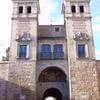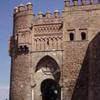Gates, City Walls and Bridges of Toledo Spain
Hard to miss from nearly any vantage point in the city, a close up at look the bridges and gates of Toledo’s Old City is its own reward. Soaring towers and mammoth fortifications testify to the strength of a city that’s maintained its borders for well over a thousand years. Each gate, each bridge, and each fortification has its own unique story to be told, so check out our favourites and see them for yourself!
Puente de San Martín (St Martin Bridge)
St. Martín’s Bridge is a late 14th century medieval bridge that connects Toledo to the west side of the river Tagus constructed to complement the much older Puente de Alcantara, linking to the east. Both sides of the bridge boast heavily fortified towers, the more recent dating from the 16th century. Try finding out who the woman in the middle is...
Puente de Alcántara (Alcantara Bridge)
Early in the second century, the Romans built this fortified stone bridge over the river Tagus to connect the city of Toledo with the river’s eastern bank. The inscription the central archway, "Pontem perpetui mansurum in saecula," or, "I have built a bridge which will last forever," testifies to the strength of its fortifications.
It is of Arabic origin, as is shown by its doubled structure, although it was rebuilt in Christian times. The opening is of a horseshoe arch and is flanked by two square towers with lateral arrow slits. Its structure has been preserved until now because of being walled up from the XVI Century until 1911.
The space between the door and the bridge forms a closed square with two other side doors.
Puerta Bisagra Nueva (Bisagra Gate)
Originally called Bab al-Saqra, the gate was built by the Moors in the 10th century. Rebuilt in 1559, it served as the city’s main gate and adopted the name Puerta de Bisagara Nueva. Two mammoth circular towers stand at the outer gate and two commanding towers at the inner gate make for an imposing and impressive introduction to the city.
It was totally rebuilt during the reigns of Carlos V and Felipe II, following the designs of Alonso de Covarrubias. It is made up of two bodies, between which is placed a "plaza de armas" (main square).
The enormous exterior body is composed of a stone triumphal arch crowned by a huge imperial coat of arms of the city, with its unmistakeable two-headed eagle flanked by two large stone semicircular towers showing the figures of the seated monarchs, a symbol of the good government shown by the medieval coat of arms.
The interior body is composed of a rounded arch flanked by square towers crowned with ceramic steeples, the imperial coat of arms of Carlos V appearing on one of them, the others being chequered.
The monumental and not defensive nature is made patently clear by the investment in towers placed almost flush with the floor and rocks in relief crowning the towers.
Puerta del Cambrón (Cambron Gate)
Near the Puente de San Martín, where a Visigoth gate once stood, this gate was rebuilt in the 16th century, and retains only a piece of the original structure on its outer façade. Originally a Muslim door, heavily altered. In its current version it dates from 1576, and was built on a square base, with an interior patio surrounded by four towers covered by slate capitals. Its name comes from cambroneras, thorny bushes that grew here.
The structure has two gates and four towers and took on the nickname "Jew’s Gate" for a time, as it linked the river Tagus’ western bank to Toledo’s Jewish Quarter. On both sides there are Renaissance entrances with coats of arms, that of the city on the outside and of Felipe II on the inside. Below this can be senn a fine image of Santa Leocadia, patron saint of Toledo and of this door, which is the only one open to road traffic.
Puerta del Sol (Gate of Sun)
This medieval city gate can be found along the road from the Bisagra gate to Zocodover Plaza. The medallion above the arch of the gate depicts the ordination of the Visigothic Ildephonsus, Toledo’s patron saint. The name of the gate comes from the sun and the moon that were once painted on either side of this medallion.






